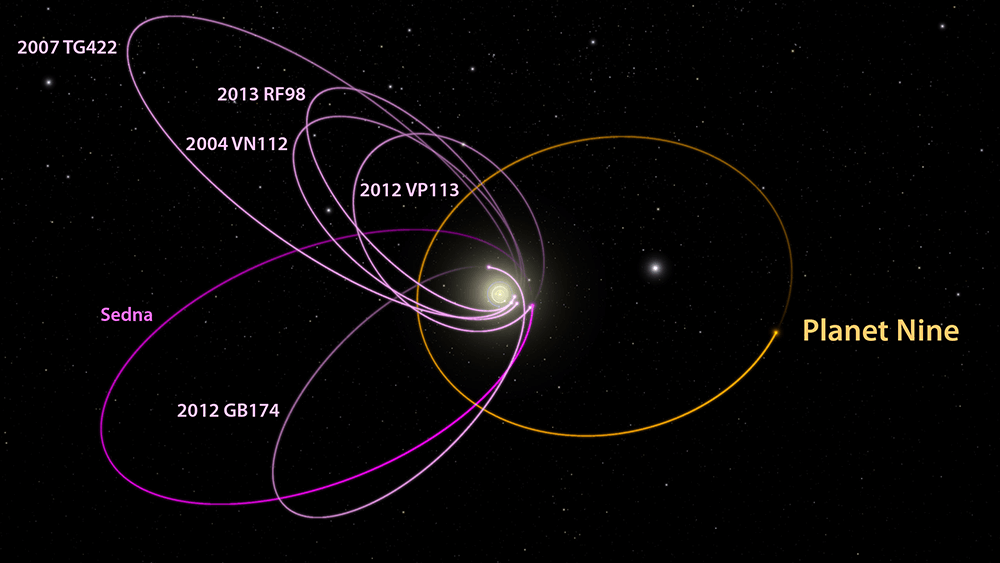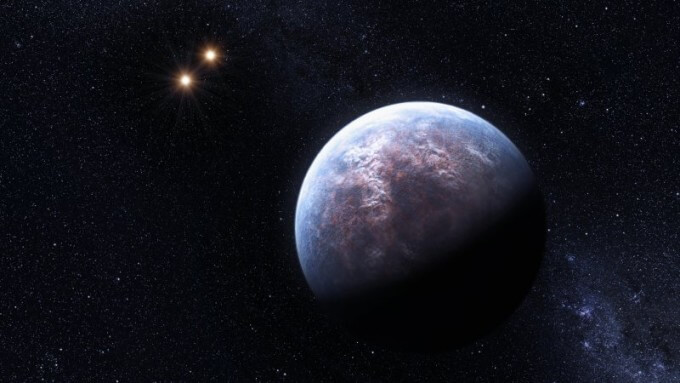- Get link
- X
- Other Apps

In the middle of the 19th century, astronomers suggested that there should be a planet between the Sun and Mercury, another planet of our Solar System. They did not even see her, but calculated the orbit and dubbed Vulcan. According to them, only the planet could explain the small deviations in the orbit of Mercury. Years passed, and astronomers looked at all the eyes, but Vulcan was never found. And in 1915, Einstein's theory of relativity explained Mercury's strange behavior, eliminating the need for Vulcan. Search forgot. What are we all about?
The volcano is one of many planets whose existence in our solar system was incorrectly predicted for decades.
Nibiru, Tyche, as well as various “planets X” beyond the orbit of Neptune, drove the naive public to a shiver, frantically stirring the imagination and stirring up imagination. And only once did mathematical modeling prove correct. This case is well known. The existence of Neptune - the eighth and farthest from the known planets from the Sun - was derived from the burden that it exerted into the orbit of Uranus.
Scientists set up telescopes, and discovered the planet in a matter of days.
A few days ago, a duet of American astronomers said that he hoped to find another planet beyond the orbit of Neptune - a giant ten times more massive than Earth. The not yet open “Ninth Planet” would ideally explain the quirky movement of an accumulated small group of comet-like bodies in the outer chambers of our solar system.
The proposal to add a planet to the arsenal of the solar system caused great excitement, but experts warn: as long as theory remains a theory. It may take years to confirm it.
“The work they have done is impressive. They collected a lot of information, they were very careful. But actually this is only the first step, ”said Edward Blumer of the Royal Greenwich Observatory. - Many people around the world will study this information. Even if the team itself decides to reconsider, it will find something new. ”
Needle in a haystack

Astronomers constantly use simulations to predict the existence, nature and behavior of things they cannot see. Black holes, for example, are “observed” solely by their influence on the surrounding stars.
“Nothing can be accurate if it is based on modeling,” says François Voget from the LMD Institute in Paris. “That is the nature of science.”
Take Pluto, for example. It was discovered in 1930 by chance, it was found by astronomers who were looking for the ninth planet explaining the orbital anomalies of Neptune and Uranus. At first, Pluto fit the model perfectly. But later it turned out that he was too small to be a real planet, and in 2006, Pluto was reclassified into a dwarf planet.
Yet the latest evidence in favor of a hypothetical planet was “more convincing” than other recent assumptions, says Morgan Hollis of the Royal Astronomical Society.
But, again, "this study only shows that the planet may be a possible solution ... it could be something else." Alessandro Morbidelli of the JL Lagrange Research Institute in Nice, in the south of France, believes that the season of planet hunters with telescopes is open. But it will not be easy. If the planet exists, it is very, very far, where the light of the Sun almost does not reach.
“We have no idea where the planet’s orbit is,” says Morbidelli. “It's like looking for a needle in a haystack.”
Modeling is, of course, inaccurate science, and "wild statements" about new planets are shrinking as technology advances. The analysis becomes more sophisticated, and people are more careful. Everything is checked twice. Blumer says that he would not have yet put a penny that they would find the ninth planet.
“Not because I think this is unlikely, but because at this stage, although everything looks tempting, and the guys have done a lot of good work, this is still the first step.”
In a beautiful, energetic and technically brilliant work, scientists Konstantin Batygin and Mike Brown from Caltech put the whole world on their ears. In short, the strange cluster orbital configurations of a handful of distant Kuiper belt bodies are the easiest to explain due to the gravitational perturbations of the planet with a mass of at least 10 Earth, rotating at 700 amperes. e., with an ellipticity of 0.6 (which translates into an orbit of 19,000 years long).
The possible appearance of a giant planet in our solar system raises many questions. Some of them have already begun to receive answers.

Will it be “super-earth” or “mini-neptune”?
Rather, mini-Neptune (this term may have first appeared in the work of 2009). From what we learned about the formation of planets and exoplanet populations, a world with such a mass will probably be covered with a deep atmosphere in which primary hydrogen and helium will prevail. Since the mass of Neptune is 17 times larger than that of the earth, the newly proposed world will be more like the younger of the Arctic giant worlds, rather than the oldest of the solid planets.
What will this mean for the status of our solar system?
Until now, the Solar System has been considered somewhat unusual in terms of planetary content and architecture compared with the abundance of open exoplanetary systems. In particular, most planetary systems around cold stars contain at least one world with a mass between the Earth and Neptune (this is observed in 60% of the systems). Adding a mini-Neptune around the Sun will immediately put us in a more ordinary category - is it good or bad for you to decide.
Can this planet be habitable?
At first glance, you can decide what is not. It is far from the Sun and receives very little solar heat. But the dense hydrogen atmosphere, with high pressure at depth, is particularly opaque to infrared radiation and serves as an excellent thermal blanket. It is so good that the warmth of the initial formation of this world with a mass of ten earthly may not have completely leaked. It is possible that somewhere in the depths of the conditions of this world allow water to exist - which makes this world a dark ocean, the surface of which in terms of pressure and temperature can be compared with the ocean's abysses of the Earth. Whether she can sustain life is another question. Perhaps the planet did not have enough chemical fertilizer to put the biological system into operation.
What the hell did she forget there, this planet?
Although our theories about the formation of planets, for the solar system and other places, are far from completion or confirmation, they include ideas that allow such worlds to exist. Traditional astrophysical wisdom tells us that if the early solar system did not have an extremely large and rich protostar disk, a planet of this size could hardly form far from the star - it would not have enough material. But several promising models that appeared 4.5 years ago and explain the dynamic swinging and orbital restructuring of large planets include the fifth gigantic world. To come to the order that we see in the inner worlds today and in the Kuiper belt, such a planet had to play the role of a sacrificial mass — to be thrown away. It could even be thrown into interstellar space - as an “outcast” - or sent to a long and very elongated orbit. The planet proposed by Batygin and Brown could well fit.
So. Will it be the ninth planet?
The whole process of classifying planets serves (in principle) to increase our scientific understanding, but at the same time, history plays an important role. If this object was formed among other giant worlds, then it should definitely be considered the ninth largest planet.
The article is based on materials .
- Get link
- X
- Other Apps
Comments
Post a Comment